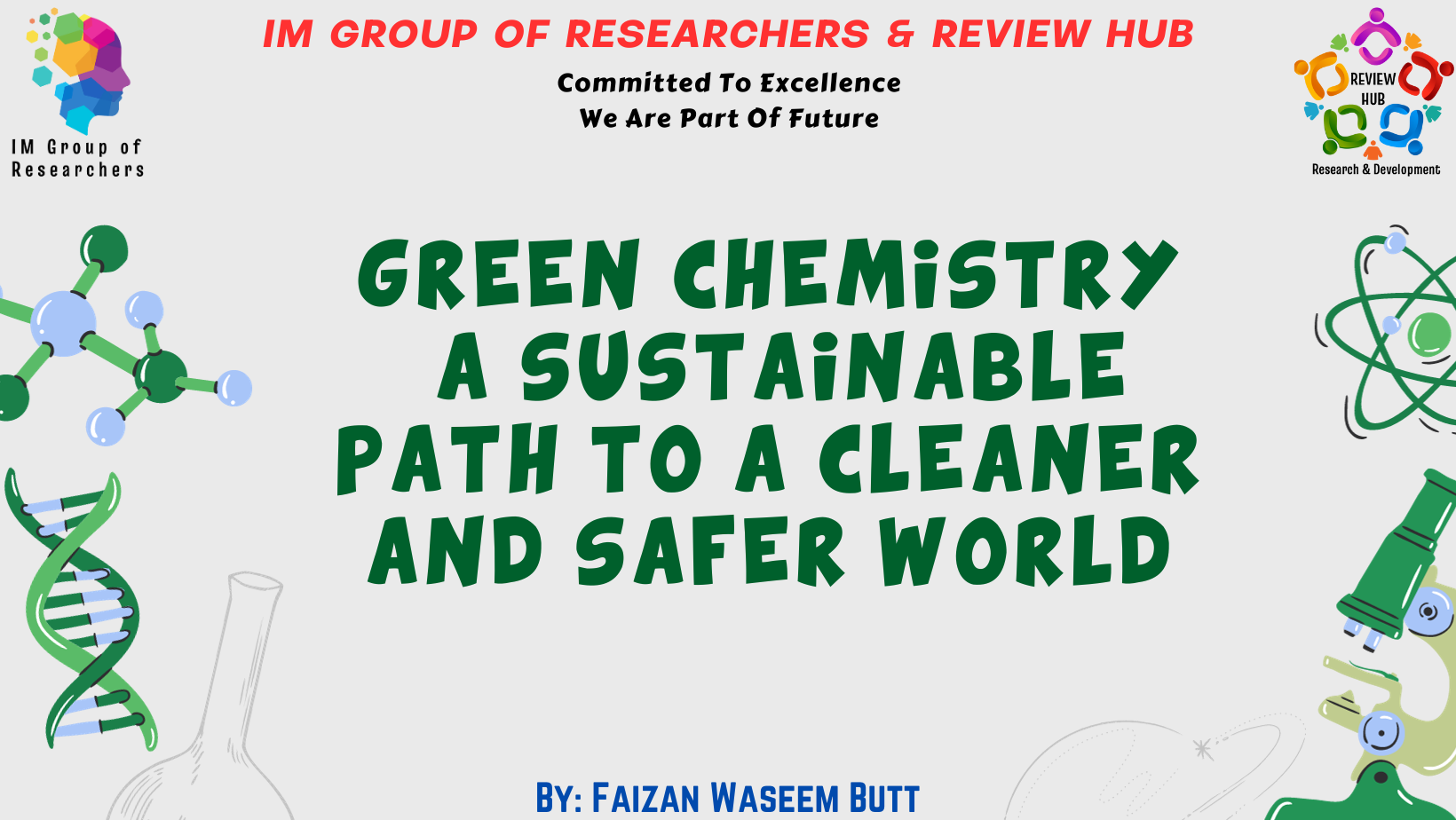Green Chemistry: A Sustainable Path to a Cleaner and Safer World
Green Chemistry: A Sustainable Path to a Cleaner and Safer World. In a world facing increasing environmental challenges, green chemistry has emerged as a beacon of hope for a more sustainable future. This revolutionary field, also known as sustainable chemistry or eco-friendly chemistry, focuses on the design, development, and application of chemical products and processes that minimize environmental impact while maximizing efficiency. With growing concerns about climate change, pollution, and the depletion of natural resources, green chemistry has become an essential component of our global efforts to reduce our ecological footprint.
Author
Faizan Waseem Butt

Introduction
In a world facing increasing environmental challenges, green chemistry has emerged as a beacon of hope for a more sustainable future. This revolutionary field, also known as sustainable chemistry or eco-friendly chemistry, focuses on the design, development, and application of chemical products and processes that minimize environmental impact while maximizing efficiency. With growing concerns about climate change, pollution, and the depletion of natural resources, green chemistry has become an essential component of our global efforts to reduce our ecological footprint.
This article will delve deep into the world of green chemistry, exploring its principles, applications, and the immense benefits it offers to both the environment and human health. Join us on this journey as we unravel the potential of green chemistry to revolutionize industries and pave the way for a cleaner and safer world.
1. Understanding Green Chemistry
1.1 Principles of Green Chemistry
Green chemistry is guided by a set of principles that aim to minimize the environmental and human health impacts of chemical processes and products. These principles, as outlined by Paul Anastas and John Warner, can be summarized as follows:
Prevention: It is better to prevent waste generation than to treat or clean up waste after it is produced.
Atom Economy: Chemical reactions should be designed to maximize the incorporation of all materials used into the final product.
Less Hazardous Chemical Syntheses: Whenever possible, synthetic methods should be designed to use and generate substances that possess little to no toxicity.
Designing Safer Chemicals: Chemical products should be designed to perform their intended function while minimizing their toxicity.
Safer Solvents and Auxiliaries: The use of auxiliary substances should be avoided or, if necessary, selected to minimize their environmental impact.
Energy Efficiency: Chemical processes should be conducted to maximize energy efficiency while minimizing waste.
Renewable Feedstocks: Whenever practical, raw materials should be renewable rather than depleting.
Reduce Derivatives: Unnecessary derivatization (e.g., protecting groups) should be avoided.
Catalysis: Catalytic reagents are preferable, and wherever possible, selectivity should be achieved using catalytic reagents.
Design for Degradation: Chemical products should be designed for easy breakdown to prevent persistence in the environment.
Real-time Analysis for Pollution Prevention: Analytical methodologies should be further developed to allow for real-time, in-process monitoring and control prior to the formation of hazardous substances.
Inherently Safer Chemistry for Accident Prevention: Substances used in a chemical process should be chosen to minimize the potential for accidents, including releases, explosions, and fires.
1.2 Applications of Green Chemistry
Green chemistry has far-reaching applications across various industries, including pharmaceuticals, agriculture, energy, and materials science. For instance:
In pharmaceuticals, green chemistry principles lead to the development of safer and more effective drugs with fewer side effects.
In agriculture, sustainable pesticides and fertilizers are designed to minimize environmental harm and protect beneficial organisms.
In the energy sector, green chemistry drives the advancement of renewable energy sources and energy storage technologies.
In materials science, biodegradable and environmentally friendly materials are being developed to replace conventional plastics.
2. Environmental Benefits of Green Chemistry
2.1 Reduced Pollution
One of the most significant advantages of green chemistry is its ability to reduce pollution. By minimizing the generation of hazardous waste and the use of toxic chemicals, it contributes to cleaner air, water, and soil. This not only benefits the environment but also leads to better human health and quality of life.
2.2 Conservation of Resources
Green chemistry promotes the efficient use of raw materials, reducing resource depletion. For example, it encourages recycling and reusing chemicals, which conserves valuable resources and decreases the energy required for their extraction and production.
2.3 Energy Efficiency
The focus on energy-efficient processes is another key element of green chemistry. By optimizing chemical reactions to require less energy, it contributes to a lower carbon footprint and reduced greenhouse gas emissions
2.4 Biodiversity Protection
Green chemistry practices in agriculture minimize the negative impact of pesticides on ecosystems and beneficial organisms. This approach is essential for protecting biodiversity and maintaining ecological balance.
2.5 Safer Products
Consumers are increasingly demanding safer, environmentally friendly products. Green chemistry delivers by designing products with reduced toxicity and fewer health risks, from household cleaners to cosmetics.
3. Economic Benefits of Green Chemistry
3.1 Cost Saavings
While there may be initial investments in adopting green chemistry practices, they often lead to long-term cost savings. By reducing the need for hazardous waste disposal and regulatory compliance, businesses can lower their operating costs.
3.2 Innovation and Market Opportunities
Green chemistry drives innovation, creating opportunities for businesses to develop new, environmentally friendly products and processes. This can lead to market differentiation and a competitive edge in industries committed to sustainability.
3.3 Increased Customer Demand
As consumer awareness of environmental issues grows, there is a rising demand for eco-friendly products. Companies that embrace green chemistry are more likely to attract environmentally conscious customers and gain market share.
3.4 Regulatory Compliance
Green chemistry aligns with stringent environmental regulations. By adopting these practices, companies reduce the risk of non-compliance, which can result in fines and damage to their reputation.
4. Examples of Green Chemistry Success Stories
4.1 The Pharmaceutical Industry
The pharmaceutical sector has seen substantial benefits from green chemistry. One notable example is the development of the anti-HIV drug Darunavir. By employing sustainable chemistry principles, researchers reduced waste and increased the overall yield of the drug, making it more cost-effective and environmentally friendly.
4.2 The Automotive Industry
The automotive industry has embraced green chemistry in the development of fuel-efficient and lightweight materials. For instance, the use of lightweight, strong, and recyclable materials in electric vehicles not only reduces emissions but also conserves resources.
4.3 Agriculture and Pest Control
The development of sustainable pesticides and herbicides has been a game-changer in agriculture. Green chemistry principles have led to the creation of products that target specific pests, reducing harm to non-target organisms and minimizing the negative environmental impact.
4.4 Renewable Energy
The renewable energy sector heavily relies on green chemistry for the development of efficient solar cells, wind turbine materials, and energy storage technologies. Green chemistry is pivotal in making these technologies more accessible and sustainable.
Challenges and Future Prospects
5.1 Challenges
Despite its many benefits, green chemistry faces challenges, including resistance to change from industries entrenched in traditional practices and the need for further research and development to improve the scalability and cost-effectiveness of green processes.
5.2 Future Prospects
The future of green chemistry looks promising. As the global community intensifies its focus on environmental sustainability, it is likely that green chemistry will play an even more significant role in shaping the industrial landscape. Continued research, development, and collaboration among academia, industry, and regulatory bodies will be essential in addressing environmental challenges.
5. Conclusion
Green chemistry represents a beacon of hope in our journey towards a cleaner and safer world. By embracing its principles and applications, we can reduce pollution, conserve resources, and protect biodiversity. Moreover, the economic benefits and innovative opportunities it presents make it a win-win solution for businesses and the environment. As we face rising environmental challenges, green chemistry offers a sustainable path forward, revolutionizing industries and leading us to a future where both the environment and human health are safeguarded.
In a world that is increasingly aware of the need for sustainability, green chemistry is not just an option; it’s an imperative for a better tomorrow.
Also Read: Difference Between Research Paper & Review Paper
Follow Us on

